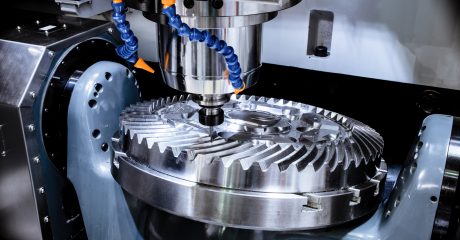Many companies require CNC machining services to make parts and prototypes, and many industries use this versatile technology. But CNC machining comes in various forms. This article discusses two of the most common forms: CNC milling and CNC turning. We dive into the essential features of CNC milling and CNC turning, while also presenting a selection of common parts that companies can manufacture using each process. For more information keep on reading.
What is CNC Milling?
CNC milling is one of the most common CNC machining services, and machinists can use it to make a wide variety of CNC machined parts. CNC mills use computer instructions to move a rapidly rotating cutting tool along three or more axes. When the spinning cutting tool makes contact with the workpiece, it removes material in a controlled manner. The cutting tool makes a succession of passes against the surface of the workpiece until the workpiece resembles the desired part.
Most CNC mills keep the workpiece stationary, holding it down on the machine bed with a vice. However, multi-axis CNC mills may rock or rotate the workpiece to create a greater number of cutting angles. This allows the machinist to create more complex parts without having to manually reorient the workpiece. Providers of rapid prototyping services use CNC milling because it is a one-stop, end-to-end process with short lead times.
What is CNC Turning?
CNC turning is a form of CNC machining that machinists use to make rounded, cylindrical, and conical parts. Although it’s less versatile than CNC milling, it is one of the most popular CNC machining services and rapid prototyping services.
Machines that carry out CNC turning are called CNC lathes or CNC turning centers. They are different from CNC mills in that they rapidly rotate the workpiece in a chuck but do not rotate the cutting tool. The cutting tool, affixed to a turret, moves towards the spinning workpiece under computer instructions and removes material where necessary.
A CNC lathe can cut the outside of the workpiece or bore through the inside to create tubular CNC machined parts. The turret of the machine may have multiple cutting tools that can be individually engaged as required.
Parts made with CNC Milling
Example parts made with CNC milling can include the following.
- Fittings: Milled fittings connect two or more parts together.
- Enclosures and housings: Electrical devices and other products can use custom-milled enclosures to protect internal components.
- Brackets: Milled brackets can contain custom threads and holes and may be more complex than sheet metal brackets.
- Gears: CNC milling can produce straight and spiral gears for mechanical devices.
- Mold tooling: Milled tooling, made of steel or aluminum, allows for rapid prototyping of molded parts.
- Engine parts: Automotive engineers use CNC milling for engine blocks and other parts.
- Medical devices: CNC mills can produce implants, surgical instruments, and other medical devices.
- Water pumps: Multi-axis mills can create reliable impellers for hydraulic equipment.
- Forming punches: CNC mills can create other manufacturing equipment, such as forming punches for sheet metal fabrication.
Parts made with CNC Turning
Example parts made with CNC turning include the following.
- Rollers: CNC lathes can fabricate rollers with tight tolerances for industrial use.
- Ball joints: CNC turning is ideal for rounded connective devices like ball joints.
- Nuts and bolts: The accuracy of turning makes it suitable for tolerance-critical items like nuts and bolts.
- Shafts: Shafts with rounded profiles are highly suited to CNC turning.
- Flanges: CNC-turned flanges can strengthen beams and pipes.
- Nozzles: Nozzles are typically cylindrical or conical with hollow insides, making them suitable for CNC turning.
- Turbines: CNC turning can produce round turbine blades for the energy industry.
- Firearms: A CNC lathe can produce the tubular shape required for a firearm barrel.
Which should you choose?
As a rule of thumb, CNC turning is best for parts with round, cylindrical, or conical profiles, and CNC milling is best for everything else. If in doubt, a machining expert from Custom Tool can guide you to the right CNC machining service for your unique project. Give us a call today so we can help you with your next project!
